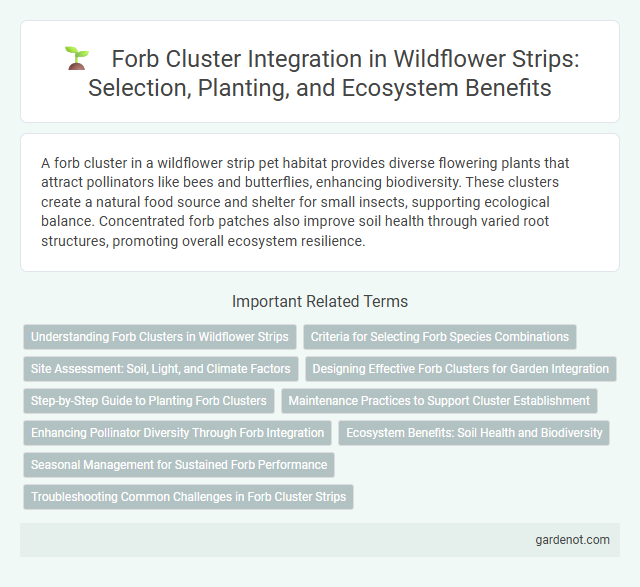A forb cluster in a wildflower strip pet habitat provides diverse flowering plants that attract pollinators like bees and butterflies, enhancing biodiversity. These clusters create a natural food source and shelter for small insects, supporting ecological balance. Concentrated forb patches also improve soil health through varied root structures, promoting overall ecosystem resilience.
Understanding Forb Clusters in Wildflower Strips
Forb clusters in wildflower strips consist of dense groupings of herbaceous flowering plants that enhance biodiversity by providing essential nectar and pollen resources for pollinators. These clusters improve habitat complexity, supporting a diverse array of insects, including bees, butterflies, and other beneficial arthropods. Understanding the spatial arrangement and species composition of forb clusters is crucial for optimizing pollinator attraction and ecosystem resilience in wildflower strips.
Criteria for Selecting Forb Species Combinations
Selecting forb species combinations for wildflower strips requires careful consideration of bloom period diversity, ensuring continuous flowering from early spring to late fall to support pollinators throughout the seasons. Species should be chosen based on compatibility in soil type and moisture requirements, promoting robust growth and reducing competition. Incorporating native forbs with varied floral structures enhances habitat complexity and maximizes ecological benefits for insects and wildlife.
Site Assessment: Soil, Light, and Climate Factors
Forb clusters thrive in wildflower strips when soil properties such as pH, texture, and nutrient levels are well suited to native species, ensuring optimal root development and nutrient uptake. Light availability, ranging from full sun to partial shade, influences photosynthetic efficiency and bloom density within forb clusters. Climate factors including temperature ranges, precipitation patterns, and seasonal variability directly impact flowering time, seed germination rates, and overall plant health in these ecosystems.
Designing Effective Forb Clusters for Garden Integration
Designing effective forb clusters involves selecting diverse native wildflower species that bloom sequentially to provide continuous color and support pollinator habitats. Grouping forbs with similar soil, light, and moisture requirements ensures healthy growth and maintenance efficiency in wildflower strips. Clustering forbs in varying heights and textures creates visual interest and mimics natural ecosystems, enhancing garden integration and biodiversity.
Step-by-Step Guide to Planting Forb Clusters
Planting forb clusters requires selecting native species that thrive in your soil and climate, ensuring biodiversity and habitat support for pollinators. Begin by preparing the soil through light tilling and removing invasive weeds to create optimal conditions for seed germination. Sow seeds in small groups to mimic natural growth patterns, water consistently, and monitor growth to maintain healthy forb clusters within your wildflower strip.
Maintenance Practices to Support Cluster Establishment
Successful maintenance of forb clusters in wildflower strips requires careful management of soil moisture and periodic removal of competing vegetation. Targeted mowing or selective herbicide application helps reduce invasive species while promoting native forb growth. Regular monitoring during the establishment phase ensures optimal conditions for robust cluster development and long-term biodiversity benefits.
Enhancing Pollinator Diversity Through Forb Integration
Forb clusters within wildflower strips significantly boost pollinator diversity by providing a variety of nectar and pollen sources essential for different pollinator species. Integrating native forbs like goldenrod, coneflower, and bee balm supports specialized pollinators such as solitary bees, butterflies, and hummingbirds, enhancing ecosystem resilience. These clusters create microhabitats that sustain pollinator populations across seasons, promoting long-term biodiversity and improving crop pollination services.
Ecosystem Benefits: Soil Health and Biodiversity
Forb clusters in wildflower strips enhance soil health by improving nutrient cycling and increasing organic matter content, which supports microbial diversity and soil structure. These diverse flowering plants provide critical habitat and food sources for pollinators and beneficial insects, boosting overall biodiversity within agricultural landscapes. The presence of forbs promotes ecosystem resilience by fostering a balanced and thriving community of flora and fauna.
Seasonal Management for Sustained Forb Performance
Effective seasonal management of forb clusters in wildflower strips ensures sustained blooming and plant health throughout the growing season. Regular monitoring and timely interventions, such as selective mowing or targeted weeding, help maintain optimal light and nutrient availability for forb species. Implementing appropriate seasonal practices enhances biodiversity, supports pollinator activity, and promotes long-term ecological stability in wildflower habitats.
Troubleshooting Common Challenges in Forb Cluster Strips
Forb cluster strips may face challenges such as poor seed germination, weed invasion, and uneven plant establishment. Addressing soil quality by testing pH and nutrient levels can improve germination rates, while targeted weed management techniques like selective mowing or herbicide application control competing vegetation. Regular monitoring and adjusting planting density help maintain healthy forb clusters and promote biodiversity within the wildflower strip.
Forb cluster Infographic

 gardenot.com
gardenot.com